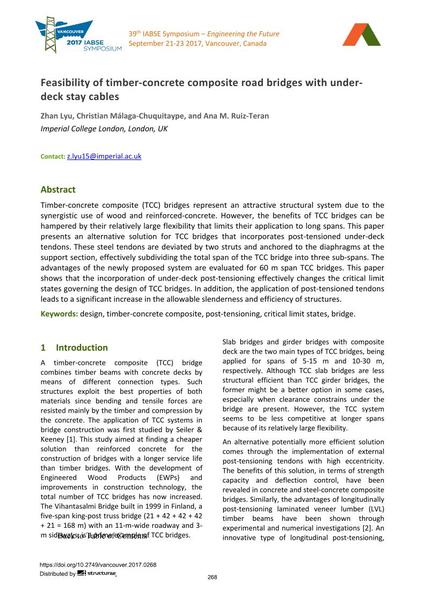Feasibility of timber-concrete composite road bridges with under- deck stay cables

|
|
|||||||||||
Bibliografische Angaben
| Autor(en): |
Zhan Lyu
(Imperial College London, London, UK)
Christian Málaga-Chuquitaype (Imperial College London, London, UK) Ana M. Ruiz-Teran (Imperial College London, London, UK) |
||||
|---|---|---|---|---|---|
| Medium: | Tagungsbeitrag | ||||
| Sprache(n): | Englisch | ||||
| Tagung: | IABSE Symposium: Engineering the Future, Vancouver, Canada, 21-23 September 2017 | ||||
| Veröffentlicht in: | IABSE Symposium Vancouver 2017 | ||||
|
|||||
| Seite(n): | 268-275 | ||||
| Anzahl der Seiten (im PDF): | 8 | ||||
| Jahr: | 2017 | ||||
| DOI: | 10.2749/vancouver.2017.0268 | ||||
| Abstrakt: |
Timber-concrete composite (TCC) bridges represent an attractive structural system due to the synergistic use of wood and reinforced-concrete. However, the benefits of TCC bridges can be hampered by their relatively large flexibility that limits their application to long spans. This paper presents an alternative solution for TCC bridges that incorporates post-tensioned under-deck tendons. These steel tendons are deviated by two struts and anchored to the diaphragms at the support section, effectively subdividing the total span of the TCC bridge into three sub-spans. The advantages of the newly proposed system are evaluated for 60 m span TCC bridges. This paper shows that the incorporation of under-deck post-tensioning effectively changes the critical limit states governing the design of TCC bridges. In addition, the application of post-tensioned tendons leads to a significant increase in the allowable slenderness and efficiency of structures. |
||||
| Stichwörter: |
Entwurf Brücke Holz-Beton-Verbund
|
||||
